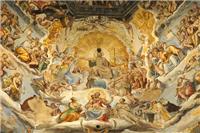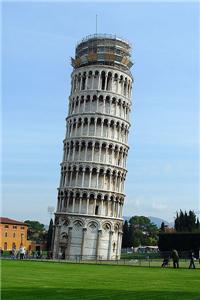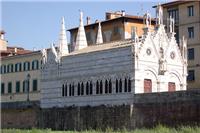The beginnings of Pisa remain rather uncertain. Of either Ligurian or Greek origin, it is at least certain that at one point it was under Etruscan rule and later that of the Longobards (or Lombards). It was during the Middle Ages that the city underwent its most flourishing economic, political and artistic period. There are still a great number of monuments from that period evident today in Pisa and can be seen in its historical centre, in the many religious and civic buildings all over the city, in the city's squares and in the narrow paths that run alongside the Arno River.

Already an important naval base in Roman times, Pisa increased its trade in the Mediterranean in the 11th century, with its fleet winning many victories over Muslim ships and cities. The Crusades in fact gave the city the opportunity to greatly expand its influence as well as its trade routes in the eastern Mediterranean and even along the African coast.
Strongly supportive of pro-imperial policies, Pisa is the only Ghibelline city in Tuscany to have openly backed the Suebi rulers, often finding itself in opposition with the papacy's position.

The slow decline of the city began in 1284 when it was crushed by its rival Genoa in the Battle of Meloria. Around 10,000 men were imprisoned or killed in the aftermath. Later, Pisa passed successively under the control of Florence and suffered a long, difficult period of its history.
In the second half of the 16th century, it began to recover as can be seen from the development of the University and the relocation to Pisa of the Order of the Knights of St. Stephen, appointed to fight the Ottomans on the sea. The city then went through a long peaceful period under the Medicis. During World War II however, the city was carpet-bombed and even went through the terrible experience of being cut in two by the warfront.

Today, Pisa is a small modern town on the banks of the Arno that has kept its allure from times past intact. The city centre is symbolized by the Piazza Vittorio Emanuele II, result of the urban reorganization which took place in the 19th century, during which time the old medieval walls were demolished. Leading off of the square is Corso Italia, the main pedestrian street, which goes to the Ponte di Mezzo, entirely made of wood at one time although it was rebuilt in the 17th century. It continues over the Arno, connecting with the northern side of the city. Many people like to walk along the riverbanks for a pleasant and romantic stroll.
The splendid Piazza dei Miracoli (Square of Miracles) encloses within its grass-covered perimeter major and well-known structures like the Cathedral, the Baptistery and the Camposanto or holy cemetery. But of course the most visible structure, widely known throughout the world, is the Leaning Tower, measuring over 50m (170 ft.) high and weighing some 15,000 tons. It owes its fame and popularity to its peculiar inclination the result of a constant shifting in the soil since the start of its construction. The Tower is actually the Cathedral's bell tower and was first built in 1173. Work on the structure was interrupted several times, very likely due in part to the fact that it could not remain perpendicular. Construction was however completed as such phenomena were not as rare at the time as one would think. Today, the Tower is subject to constant checks and maintenance work in order to ensure that it is preserved for posterity.pisa